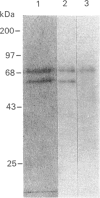Abstract
Fibronectins are a class of cell-adhesion proteins produced from a single gene. The soluble plasma form is synthesized by hepatocytes and the insoluble cellular form by fibroblasts and other cell types. The proteins possess multiple binding domains for macromolecules including collagen, fibrin and heparin along with at least one cell-binding domain. Cellular as well as plasma fibronectins are dimers of similar but not identical polypeptides. Their differences are the result of internal amino acid sequence variability due to alternative RNA splicing in at least three regions (ED-A, ED-B and III CS). We have been studying this polymorphism at the protein level in plasma fibronectin (pFn). Cathepsin D-digested pFn applied to a heparin-agarose column and eluted with an NaCl stepwise gradient (0.1 M, 0.25 M and 0.5 M) released two polypeptides (75 kDa and 65 kDa) in the 0.5 M-NaCl peak. Immunoblots with monoclonal antibodies IST-2 (specific for the C-terminal heparin-binding domain) and AHB-3 (specific for the III CS domain) suggest that both peptides contain the C-terminal heparin-binding (Hep-2) domain, but that only the larger fragment possesses the III CS region. These two polypeptides (75 kDa and 65 kDa) were digested with trypsin, and the resulting peptides were analyzed by fast-atom-bombardment mass spectrometry and compared with the known cDNA-derived peptide sequence. Peptides that were unique to the III CS region were further characterized by micro sequence analysis. The 75 kDa fragment is derived from the A-chain and contains the III CS region (89 amino acid residues) along with the C-terminal heparin-binding (Hep-2) domain and the fibrin-binding (Fib-2) domain. A single galactosamine-based carbohydrate group was detected at Thr-73/74 of the III CS region present in the 75 kDa fragment. The 65 kDa fragment is derived from the B-chain and lacks the entire III CS region but does contain the Hep-2 and Fib-2 domains.
Full text
PDF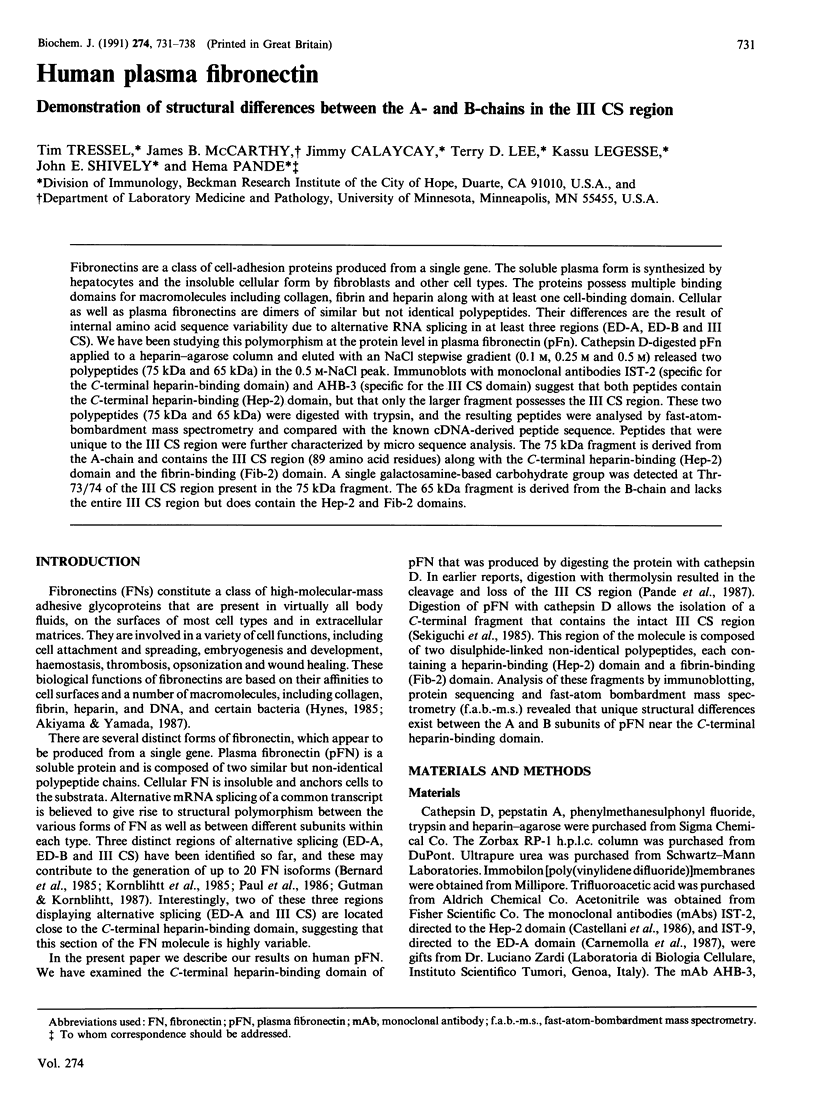
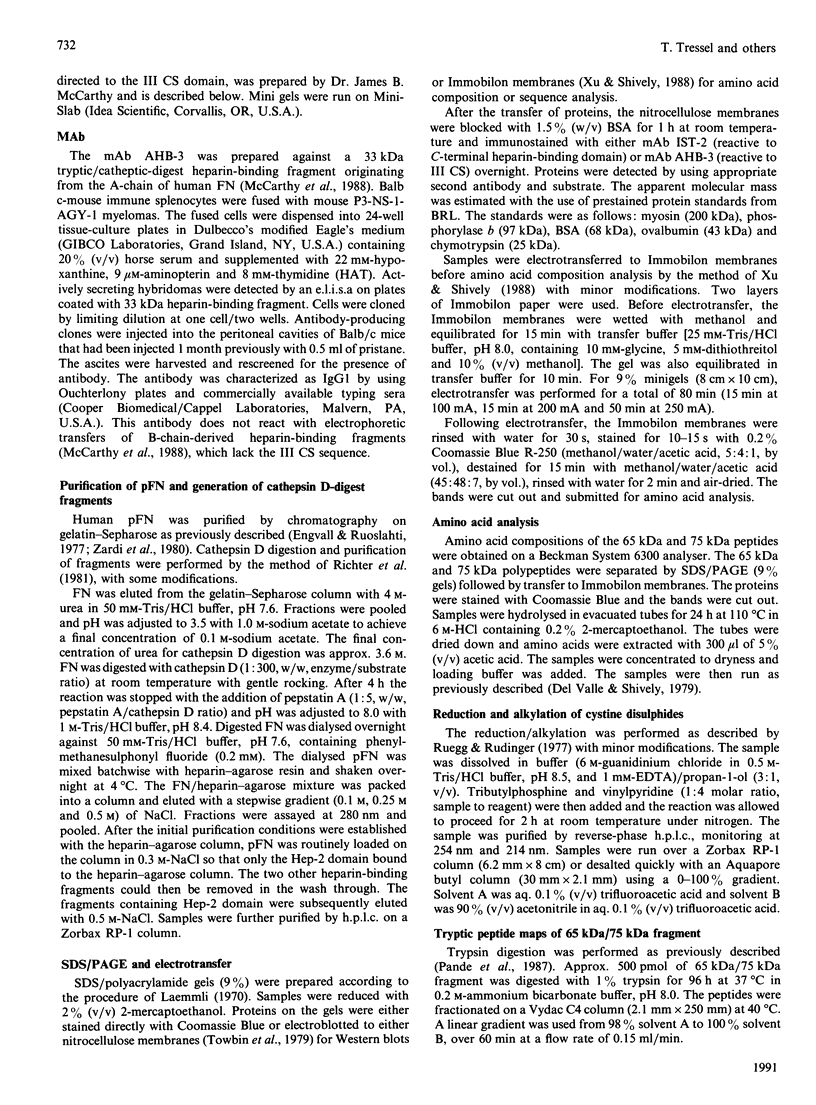
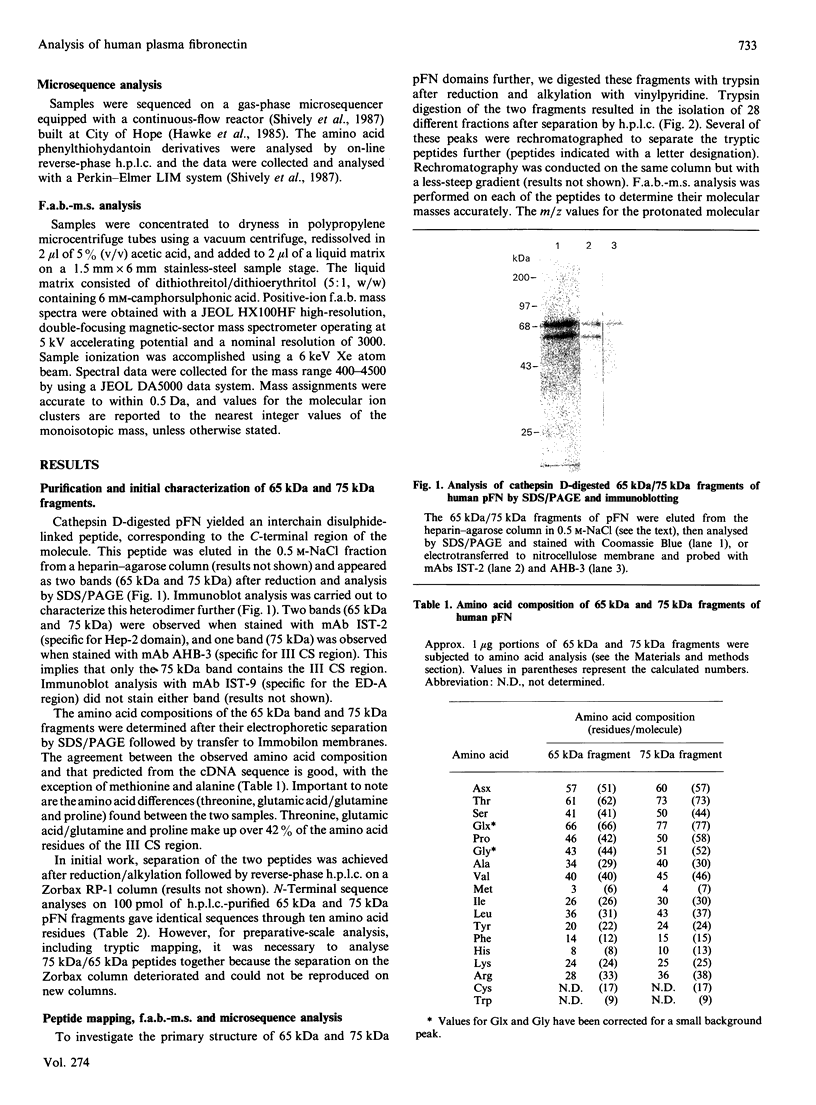
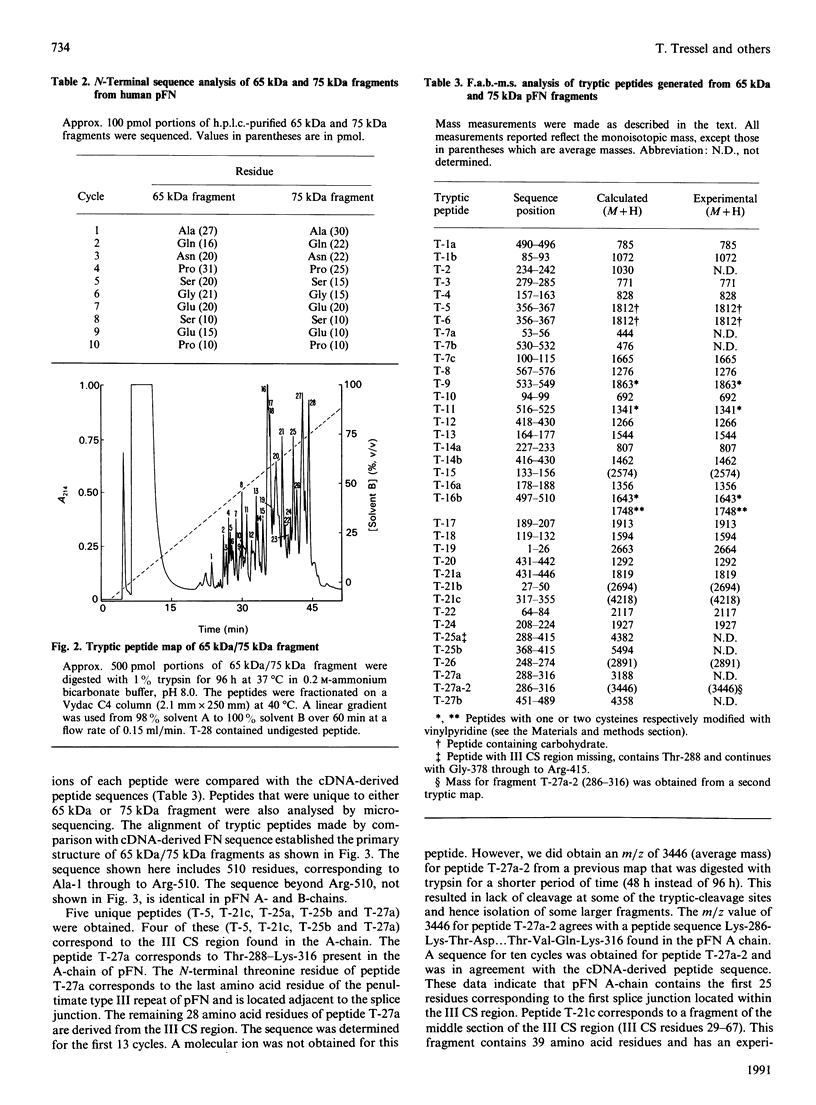
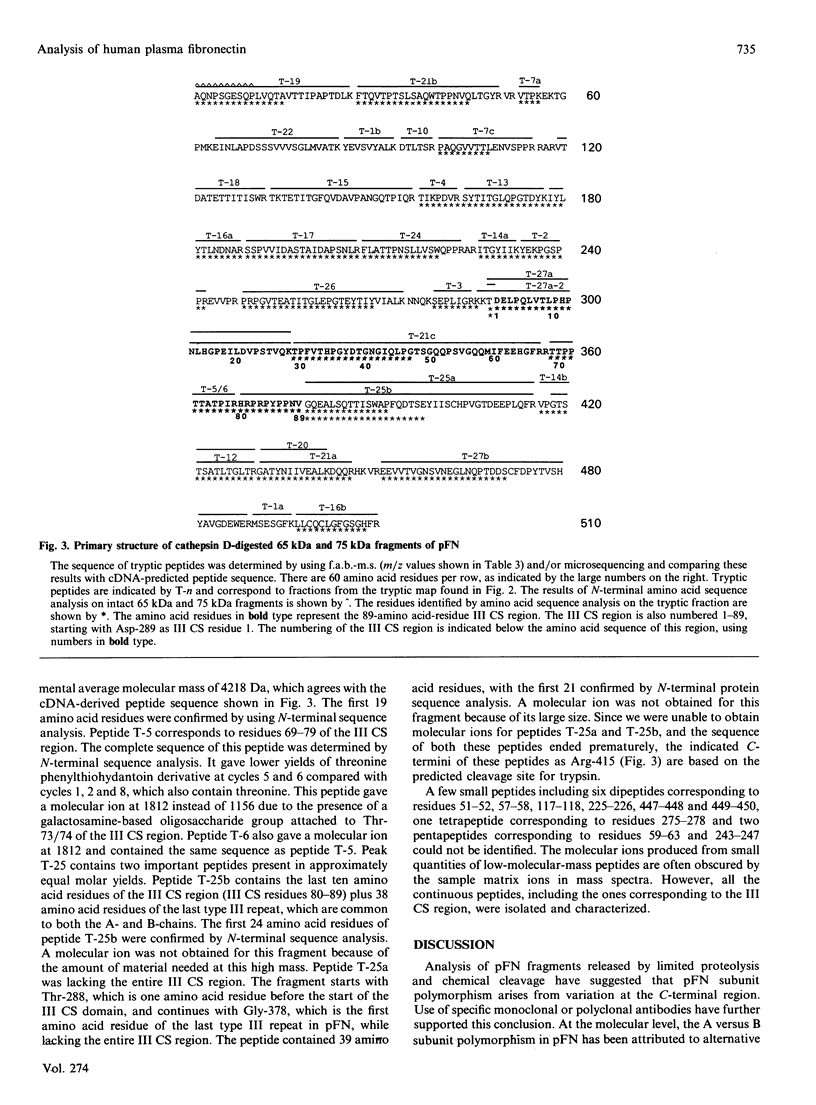
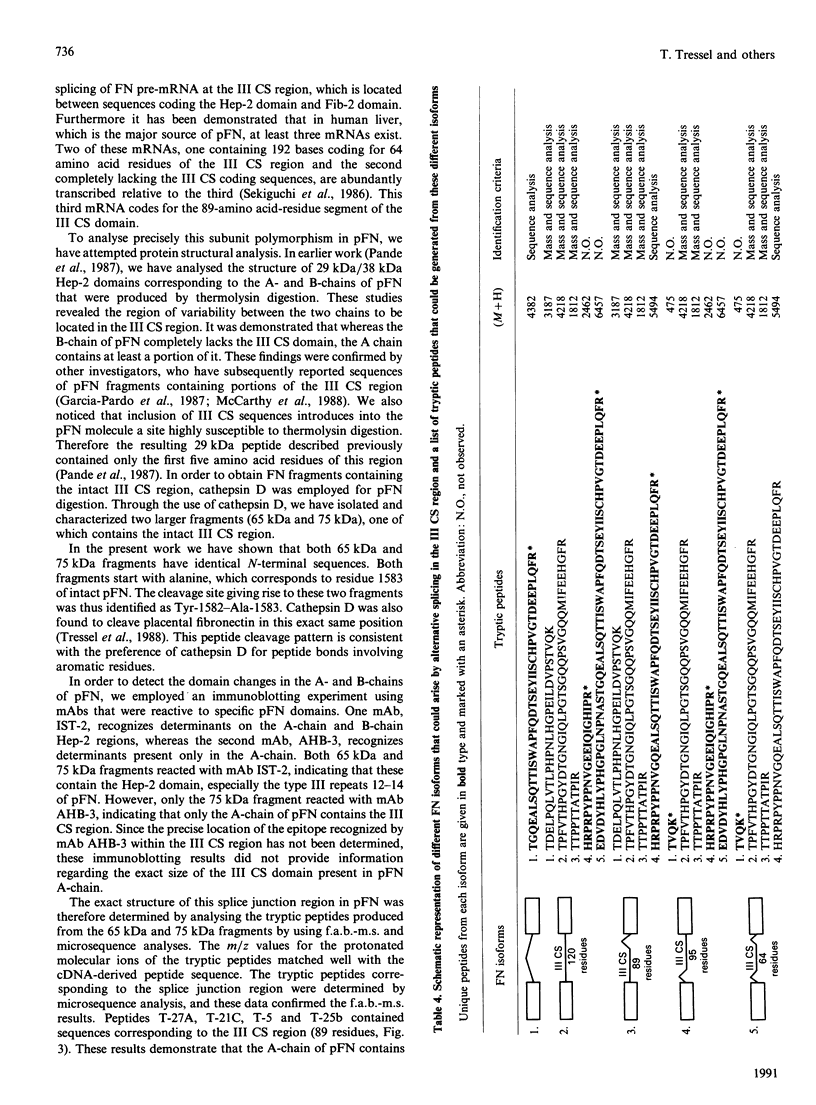


Images in this article
Selected References
These references are in PubMed. This may not be the complete list of references from this article.
- Akiyama S. K., Yamada K. M. Fibronectin. Adv Enzymol Relat Areas Mol Biol. 1987;59:1–57. doi: 10.1002/9780470123058.ch1. [DOI] [PubMed] [Google Scholar]
- Bernard M. P., Kolbe M., Weil D., Chu M. L. Human cellular fibronectin: comparison of the carboxyl-terminal portion with rat identifies primary structural domains separated by hypervariable regions. Biochemistry. 1985 May 21;24(11):2698–2704. doi: 10.1021/bi00332a016. [DOI] [PubMed] [Google Scholar]
- Carnemolla B., Borsi L., Zardi L., Owens R. J., Baralle F. E. Localization of the cellular-fibronectin-specific epitope recognized by the monoclonal antibody IST-9 using fusion proteins expressed in E. coli. FEBS Lett. 1987 May 11;215(2):269–273. doi: 10.1016/0014-5793(87)80160-6. [DOI] [PubMed] [Google Scholar]
- Castellani P., Siri A., Rosellini C., Infusini E., Borsi L., Zardi L. Transformed human cells release different fibronectin variants than do normal cells. J Cell Biol. 1986 Nov;103(5):1671–1677. doi: 10.1083/jcb.103.5.1671. [DOI] [PMC free article] [PubMed] [Google Scholar]
- Del Valle U., Shively J. E. Two-column system for determination of glucosamine, galactosamine, and amino acids on a Beckman 121MB amino acid analyzer: separation of the anomers of glucosamine and galactosamine. Anal Biochem. 1979 Jul 1;96(1):77–83. doi: 10.1016/0003-2697(79)90556-6. [DOI] [PubMed] [Google Scholar]
- Engvall E., Ruoslahti E. Binding of soluble form of fibroblast surface protein, fibronectin, to collagen. Int J Cancer. 1977 Jul 15;20(1):1–5. doi: 10.1002/ijc.2910200102. [DOI] [PubMed] [Google Scholar]
- Garcia-Pardo A., Rostagno A., Frangione B. Primary structure of human plasma fibronectin. Characterization of a 38 kDa domain containing the C-terminal heparin-binding site (Hep III site) and a region of molecular heterogeneity. Biochem J. 1987 Feb 1;241(3):923–928. doi: 10.1042/bj2410923. [DOI] [PMC free article] [PubMed] [Google Scholar]
- Gutman A., Kornblihtt A. R. Identification of a third region of cell-specific alternative splicing in human fibronectin mRNA. Proc Natl Acad Sci U S A. 1987 Oct;84(20):7179–7182. doi: 10.1073/pnas.84.20.7179. [DOI] [PMC free article] [PubMed] [Google Scholar]
- Hawke D. H., Harris D. C., Shively J. E. Microsequence analysis of peptides and proteins. V. Design and performance of a novel gas-liquid-solid phase instrument. Anal Biochem. 1985 Jun;147(2):315–330. doi: 10.1016/0003-2697(85)90278-7. [DOI] [PubMed] [Google Scholar]
- Hynes R. Molecular biology of fibronectin. Annu Rev Cell Biol. 1985;1:67–90. doi: 10.1146/annurev.cb.01.110185.000435. [DOI] [PubMed] [Google Scholar]
- Kornblihtt A. R., Umezawa K., Vibe-Pedersen K., Baralle F. E. Primary structure of human fibronectin: differential splicing may generate at least 10 polypeptides from a single gene. EMBO J. 1985 Jul;4(7):1755–1759. doi: 10.1002/j.1460-2075.1985.tb03847.x. [DOI] [PMC free article] [PubMed] [Google Scholar]
- Laemmli U. K. Cleavage of structural proteins during the assembly of the head of bacteriophage T4. Nature. 1970 Aug 15;227(5259):680–685. doi: 10.1038/227680a0. [DOI] [PubMed] [Google Scholar]
- Matsuura H., Takio K., Titani K., Greene T., Levery S. B., Salyan M. E., Hakomori S. The oncofetal structure of human fibronectin defined by monoclonal antibody FDC-6. Unique structural requirement for the antigenic specificity provided by a glycosylhexapeptide. J Biol Chem. 1988 Mar 5;263(7):3314–3322. [PubMed] [Google Scholar]
- McCarthy J. B., Chelberg M. K., Mickelson D. J., Furcht L. T. Localization and chemical synthesis of fibronectin peptides with melanoma adhesion and heparin binding activities. Biochemistry. 1988 Feb 23;27(4):1380–1388. doi: 10.1021/bi00404a044. [DOI] [PubMed] [Google Scholar]
- Pande H., Calaycay J., Lee T. D., Legesse K., Shively J. E., Siri A., Borsi L., Zardi L. Demonstration of structural differences between the two subunits of human-plasma fibronectin in the carboxy-terminal heparin-binding domain. Eur J Biochem. 1987 Jan 15;162(2):403–411. doi: 10.1111/j.1432-1033.1987.tb10616.x. [DOI] [PubMed] [Google Scholar]
- Paul J. I., Schwarzbauer J. E., Tamkun J. W., Hynes R. O. Cell-type-specific fibronectin subunits generated by alternative splicing. J Biol Chem. 1986 Sep 15;261(26):12258–12265. [PubMed] [Google Scholar]
- Richter H., Seidl M., Hörmann H. Location of heparin-binding sites of fibronectin. Detection of a hitherto unrecognized transamidase sensitive site. Hoppe Seylers Z Physiol Chem. 1981 Apr;362(4):399–408. doi: 10.1515/bchm2.1981.362.1.399. [DOI] [PubMed] [Google Scholar]
- Rüegg U. T., Rudinger J. Reductive cleavage of cystine disulfides with tributylphosphine. Methods Enzymol. 1977;47:111–116. doi: 10.1016/0076-6879(77)47012-5. [DOI] [PubMed] [Google Scholar]
- Sekiguchi K., Klos A. M., Kurachi K., Yoshitake S., Hakomori S. Human liver fibronectin complementary DNAs: identification of two different messenger RNAs possibly encoding the alpha and beta subunits of plasma fibronectin. Biochemistry. 1986 Aug 26;25(17):4936–4941. doi: 10.1021/bi00365a032. [DOI] [PubMed] [Google Scholar]
- Sekiguchi K., Siri A., Zardi L., Hakomori S. Differences in domain structure between human fibronectins isolated from plasma and from culture supernatants of normal and transformed fibroblasts. Studies with domain-specific antibodies. J Biol Chem. 1985 Apr 25;260(8):5105–5114. [PubMed] [Google Scholar]
- Shively J. E., Miller P., Ronk M. Microsequence analysis of peptides and proteins. VI. A continuous flow reactor for sample concentration and sequence analysis. Anal Biochem. 1987 Jun;163(2):517–529. doi: 10.1016/0003-2697(87)90257-0. [DOI] [PubMed] [Google Scholar]
- Skorstengaard K., Jensen M. S., Sahl P., Petersen T. E., Magnusson S. Complete primary structure of bovine plasma fibronectin. Eur J Biochem. 1986 Dec 1;161(2):441–453. doi: 10.1111/j.1432-1033.1986.tb10464.x. [DOI] [PubMed] [Google Scholar]
- Towbin H., Staehelin T., Gordon J. Electrophoretic transfer of proteins from polyacrylamide gels to nitrocellulose sheets: procedure and some applications. Proc Natl Acad Sci U S A. 1979 Sep;76(9):4350–4354. doi: 10.1073/pnas.76.9.4350. [DOI] [PMC free article] [PubMed] [Google Scholar]
- Tressel T., Shively J. E., Pande H. Human placental fibronectin: demonstration of structural differences between the A and B chains in the extra domain-A region. Arch Biochem Biophys. 1988 Nov 1;266(2):639–643. doi: 10.1016/0003-9861(88)90297-4. [DOI] [PubMed] [Google Scholar]
- Xu Q. Y., Shively J. E. Microsequence analysis of peptides and proteins. VIII. Improved electroblotting of proteins onto membranes and derivatized glass-fiber sheets. Anal Biochem. 1988 Apr;170(1):19–30. doi: 10.1016/0003-2697(88)90084-x. [DOI] [PubMed] [Google Scholar]
- Zardi L., Siri A., Carnemolla B., Cosulich E., Viale G., Santi L. A simplified procedure for the preparation of antibodies to serum fibronectin. J Immunol Methods. 1980;34(2):155–165. doi: 10.1016/0022-1759(80)90169-6. [DOI] [PubMed] [Google Scholar]



